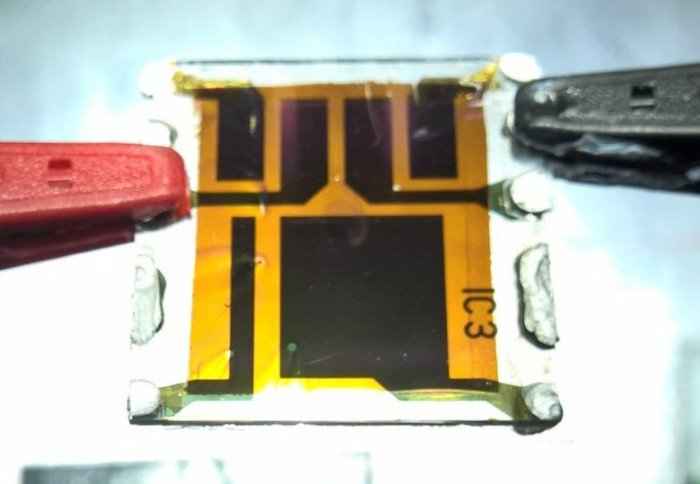

Scientists have identified an unexpected cause of poor performance in a new class of flexible and cheap solar cells, bringing them closer to market.
Solar cells are the building blocks of photovoltaic solar panels. They are made from light-absorbing materials that convert sunlight into electricity. Normally the light-absorbing material is silicon, which has an energy-intensive manufacturing process.
In the new study, scientists looked at solar cells made from materials known as perovskites. These can be produced cheaply from chemicals mixed into printable or sprayable ink, which then crystallises to form light-absorbing films.
A little bit like Agatha Christie’s Murder on the Orient Express, we’ve shown that they both ‘did it’.
– Dr Piers Barnes
However, perovskite films contain charged defects that are likely to impair their performance. Slow movement of these defects is thought to be responsible for a process known as hysteresis, which leads to irregularities in the efficiency with which light is converted to electrical current.
Light-generated electricity exits the solar cell in the form of electrons to be harnessed. This is done via ‘contacts’ that sandwich the light-absorbing film. Previously, scientists have managed to remove hysteresis by using more ‘selective’ contact materials that ensure a one-way flow of electrons out of the solar cell.
In theory, changing these contact materials shouldn’t have any effect on the movement of the charged defects within the perovskite, so it has remained a mystery why this appeared to ‘fix’ the hysteresis problem.
Now researchers from Imperial College London and collaborators have developed new experiments to follow which direction electrons move in the solar cell when they are generated with a short pulse of light.
They found that the mobile charged defects are still present even in solar cells with very efficient contact materials, despite these cells showing no hysteresis. Hysteresis was only found when cells suffered the combined effects of both the defects and poor selectivity at the contacts. The results are published today in the journal Nature Communications.
Whodunit?
Dr Piers Barnes, from the Department of Physics at Imperial, who led the study said: “Previously there was debate over whether the charged defects or the contact materials were responsible for hysteresis. A little bit like Agatha Christie’s Murder on the Orient Express, we’ve shown that they both ‘did it’.
“The field has made amazing progress, and we’re on the right track by reducing problems with the contacts. However, the results also show that improving the contacts is only part of the solution, and we still need to be concerned about the charged defects moving inside the perovskite.”
The charged defects may provide a chemical weak point which could lead to the eventual degradation of the perovskite film. This raises a potential concern over the solar cells’ long term stability.
Dr Barnes said: “The new techniques we have designed will allow the community to assess the extent of charged defect movement to help the future research needed to improve the stability and bring this technology to market.”
Now that the causes of hysteresis have been uncovered, there are a few challenges that must be overcome before perovskite solar cells can be commercialised. One concern with current perovskites is that they contain small amounts of lead in their chemical structure. A replacement metal will probably have to be found before they are deemed safe at larger scales.
Scientists will also have to reproduce their laboratory results with life-sized solar panels. However, the crucial challenge will be to find a way of improving the long-term stability of the perovskite materials.
-
'Evidence for ion migration in hybrid perovskite solar cells with minimal hysteresis' by P Barnes et al is published in Nature Communications.
Article text (excluding photos or graphics) available under an Attribution-NonCommercial-ShareAlike Creative Commons license.
Photos and graphics subject to third party copyright used with permission or © Imperial College London.
Reporter

Bruno Martin
Communications and Public Affairs

Contact details
Email: press.office@imperial.ac.uk
Show all stories by this author



Leave a comment
Your comment may be published, displaying your name as you provide it, unless you request otherwise. Your contact details will never be published.